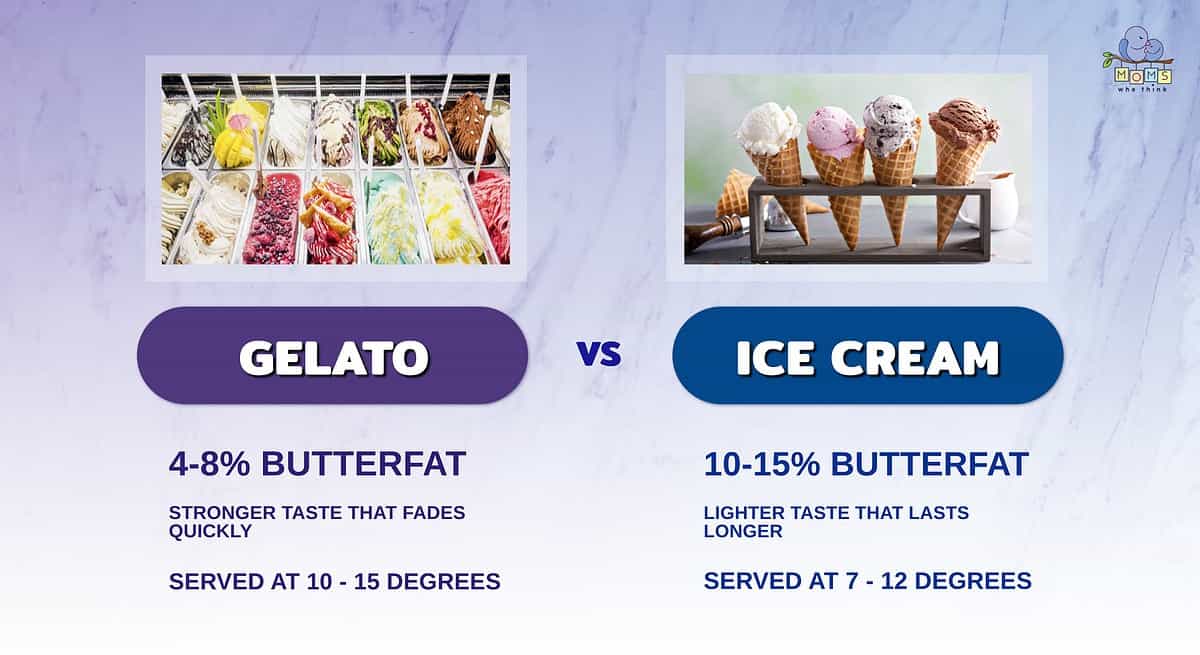Gelato vs. Ice cream: what a sweet debate, perfect for this summer! While many use the terms gelato and ice cream interchangeably, the former is an Italian term for “frozen,” while the latter is an American term.
Gelato and ice cream appear to be very comparable when seen from the surface: both are cool sweet treats that don't need any baking or frying. While both contain comparable ingredients, that is about where the similarities reach their final point.
Join us as we dispel myths and delve into the delightful intricacies of Gelato and Ice Cream, examining seven key differences that will leave you savoring every word and needing a frozen treat as you reach the end of this epic comparison!
Differences Between Gelato and Ice Cream
While both of these icy favorites strive to satisfy our sweet tooths, both of them also have a unique set of qualities that distinguish them apart. So here are the key differences you need to know in your next sweet frozen treat endeavor:
- The must-have convenient reference guide for every home cook!
- Includes more than 8,000 substitutions for ingredients, cookware, and techniques.
- Save time and money on by avoiding trips to grab that "missing" ingredient you don't really need.
1. Ingredients
Dairy-based gelato and ice cream have an identical base of components, such as milk, cream, egg yolks, and sugar. However, the proportions that go into the two recipes vary greatly.
Gelato typically uses a higher percentage of milk and less cream. Additionally, unlike ice cream, gelato often does not include egg yolks. Also, butterfat is significantly less in gelato—by around two-thirds less. Gelato only has 4% to 8% butterfat, while ice cream contains 10% to 15%.
Moreover, in the United States, there isn't any statutory amount requirement for gelato. However, all gelato in Italy is required to have at least 3.5% milk fat.
On the other hand, ice cream in the United States has a requirement of at least 10% milk fat.
2. Process
Gelato is also a bit thicker than ice cream since it is churned slowly, and no air is whipped into its final form. The blend contains less air, which results in a dense consistency and more potent flavors. Particularly in Italy, gelato is more frequently created by hand rather than by machine, which usually ends in a product of greater caliber.
3. Taste
There may have been a time when you simultaneously ate ice cream and gelato, in which case you undoubtedly observed that the gelato's taste was stronger. The increased butterfat concentration of ice cream overpowers its flavor, and the low temperature dulls the taste buds, making the taste less distinct. Gelato comes in more complex flavors since it has less fat than regular ice cream.
Because gelato has less fat and quickly loses taste, Tyler Malek, lead ice cream maker at Salt & Straw, chooses it for mild flavors like fruit. Gelato's density makes it possible to get more fruit flavors into each mouthful, although ice cream is better at retaining flavors from powerful, fragrant ingredients. The additional fat prolongs the duration of the flavor in the mouth.
4. Serving Tools
In contrast to ice cream parlors, gelato stores frequently use paddles. This particular concept enhances the dessert's appeal as a classic staple. Any store you purchase from ought to be mindful that creating and selling real gelato is an art.
5. Temperature
If you are someone who enjoys taking your time with what you're eating, you should be aware that gelato melts faster than ice cream. Ice cream comes in a frozen state, which reduces the taste intensity. However, it makes it ideal for hot days in the summer. Unlike ice cream, gelato can be consumed at a warmer temperature. Gelato is normally served at a temperature of 10-15 degrees, whereas ice cream is usually served between 7-12 degrees. Gelato's consistency is smoother and more velvety than ice cream since it is not nearly entirely frozen.
6. Texture
The best-consumed gelato must be semi-hard. Its texture should be even and homogeneous. It must disintegrate in your mouth smoothly but not too quickly. The size of the frozen particles influences the silky feel of the ice cream's consistency. Smaller ice crystals produce an even texture, and bigger ones produce a grainy one.
Gelato has a considerably rich and dense consistency, while ice cream is creamy, fluffy, and milky. Gelato is also softer, in contrast to ice cream, which is airier and has more fat. It may carry a lot more flavor in it than regular ice cream because of its density. Compared to other ice cream varieties, gelato generally has 70% less air in it and 30% more flavors. In other words, because gelato is thicker and more flavorful than ice cream, you receive more gelato per scoop. The ice cream's silky smooth thick, and creamy consistency is a result of the granules of fat from milk. In general, the end result is going to be creamier the higher the milk fat percentage.
7. Cost
Compared to ice cream, gelato is a considerably more premium product. Gelato might cost up to 50% more than ice cream since it has more taste and components overall. In fact, it is healthier and far better in terms of ingredient quality, consistency, and taste.
What is Gelato?

Gelato has less fat than conventional ice cream.
©JM Travel Photography/Shutterstock.com
Every type of ice cream is commonly referred to as gelato in Italian since the word is the general term for ice cream, which essentially means “frozen,” regardless of the flavor. Like ice cream, gelato is an Italian frozen treat. Gelato is just Italian ice cream that has the exact same components as American ice cream but in varying quantities. If you're watching your fat intake, gelato has less fat than conventional ice cream since it's prepared with milk rather than cream.
- The must-have convenient reference guide for every home cook!
- Includes more than 8,000 substitutions for ingredients, cookware, and techniques.
- Save time and money on by avoiding trips to grab that "missing" ingredient you don't really need.
When Americans discovered the potent flavor, organic components, and nutritional benefits of gelato, they started to recognize its outstanding taste, and gelato shops are popping up in every corner of the country at this moment.
Origin of Gelato
Bernardo Buontalenti, the architect of the Medici, was the very first to develop gelato. Bernardo Buontalenti (1531-1608) was a Florentine architect, theater designer, military engineer, and painter. The Medici family recruited him to design an extravagant meal to celebrate the arrival of the King of Spain in the late 1500s.
He presented his unique take on “frozen sweets” to the Medici family, one of the most influential families in Europe, acknowledged for their impeccable taste and support of artistic endeavors. While Buontalenti is its creator, Francesco Procopio dei Coltelli is credited for making it well-known in Europe. In Paris, Procopio established the Procope café, which grew to become a center for numerous novelty goods. Across France and Europe, gelato has become increasingly popular.
Before, there were two different kinds of gelato: sorbetto, produced by mixing water and juice from fruits like oranges and berries, and then gelato, done using cream and cinnamon, pistachio, coffee, and cocoa.
Fun Facts about Gelato
- Gelato's serving technique is essential. Never use a scoop when serving gelato; instead, use a paddle or another flat-surfaced item to serve this.
- Gelato was present around the 15th century, but it wasn't until the 1920s or 1930s that it truly began to gain recognition when the very first gelato cart was established in the northern Italian city of Varese.
- The competition for the title of Gelato Champion happened during the Gelato Festival in Florence, which is held every summer.
What is Ice Cream?

Ice cream is a sweetened frozen food that is frequently consumed as a sweet treat.
©Elena Veselova/Shutterstock.com
Despite being a beloved pleasure for countless decades, ice cream has only recently grown more popular due to the widespread usage of refrigeration. Ice cream is a sweetened frozen food that is frequently consumed as a sweet treat. While flavor mixtures frequently include organic components such as sugar and fruit, more than 70 percent of ice cream's components are still made from milk.
To improve flavor, texture, or appearance, small amounts of stabilizers, flavors, colorants, and emulsifiers may also be incorporated. You also have the choice of using either cream or milk as its base, then enhance it with any kind of sweetener, spices, like vanilla, or even fruits.
Its great popularity and costly manufacturing expenses stimulated the ideas of innumerable entrepreneurs, who eventually allowed the birth of the present-day ice cream business after decades of hardship.
Origin of Ice cream
The historical roots of frozen treats are unknown, while numerous tales of their past persist. While no precise date of creation or founder has been unquestionably attributed to its development, it is generally accepted that ice cream has been around since the second century B.C. Alexander the Great reportedly loved snow and ice sweetened with syrup and nectar.
Ice cream was first documented, or perhaps anything that resembled it, during Cyrus the Great's rule over Persia during the time of the Achaemenid Empire around 500 BC. In the sweltering summers, they would put grape juice on top of snow before eating it to make it flavorful. The Persians created ice cream to serve their aristocratic households around 400 BC.
Fun Facts about Ice Cream
- With an average of 48 pints consumed per person annually, the United States has the highest rate of ice cream consumption worldwide.
- People purchase ice cream in the U.S. annually for over 21 billion dollars.
- George Washington, the first president, had a collection of ice cream-related accouterments about him at all times, as he'd always been an ice cream enthusiast.
Calories in Gelato vs. Ice Cream: Which is Healthier?
In comparison to ice cream, gelato often has fewer calories, fewer grams of sugar, and less fat per serving. Based on the flavor, one scoop of gelato (100 grams) has around 207.5 calories, with 9 grams of fat, 17 grams of sugar, and 4 grams of protein.
A basic scoop of vanilla ice cream contains approximately half a cup and has around 137 calories, according to the USDA. Additionally, it has 21 grams of sugar, 12 grams of fat, and 4 grams of protein.
But it's also important to remember that these are only rough estimates and that the number of calories might change greatly depending on the components and portion size. When deciding between gelato and ice cream based on their calorie levels, the amount you eat and the flavors you want will ultimately determine how many calories you consume.
Conclusion

- Gelato has significantly less butterfat, on average, than ice cream. Plus, it typically has less milk fat than ice cream.
- Gelato is usually served at a warmer temperature than ice cream.
- Due to the lower butterfat content in gelato, it has a stronger taste than ice cream. However, the taste of ice cream tends to last longer.
They begin with almost the same ingredients and go through a churning process to create a silky, creamy pleasure, but there are still certain characteristics that separate them.
Although each has its own special characteristics, gelato is healthier due to having fewer calories, sugar, and fat than ice cream. Also, you churn ice cream quickly, creating more air in the mixture. Thus, its volume grows significantly.
Consequently, whether you're in the mood for a creamy symphony or a lighter pleasure, enjoy every bite of frozen treat in moderation and allow the icey bliss to whisk you away to a realm of pure indulgence.
- The must-have convenient reference guide for every home cook!
- Includes more than 8,000 substitutions for ingredients, cookware, and techniques.
- Save time and money on by avoiding trips to grab that "missing" ingredient you don't really need.
The image featured at the top of this post is ©LeManna/iStock via Getty Images

